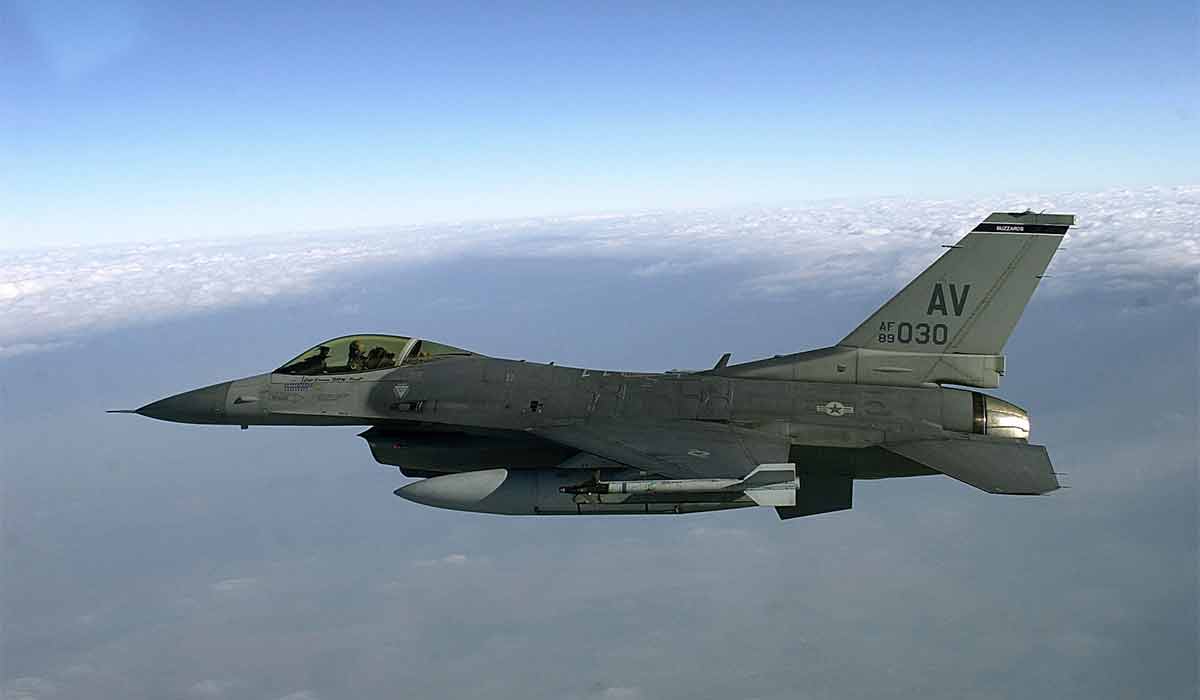F-16s Intercept Skylane Pilot Amid Presidential TFR Violation
The interception of the Cessna 182 took place over Southern California.

The F-16 Fighting Falcon is a highly-maneuverable multi-role fighter aircraft. [Courtesy: U.S. Air Force]
The pilot of a Cessna 182 over Southern California had an up-close look at a pair of U.S. Air Force F-16s last week when he violated restricted airspace set up for the protection of President Biden.
The airplane was identified as a 1973 182P Skylane, N58960. It is registered to 68-year-old Ed Regan of Torrance, California.
According to CBS News, Regan was the pilot flying when he entered the restricted airspace. He told CBS News he “knew something was wrong,” but only after he had flown into the TFR.
FLYING's attempts to reach Regan for comment were unsuccessful.
According to FlightAware.com, the pilot took off from Kingman, Arizona, at 12:31 p.m. with a destination of Chino, California. The flight path appeared to be direct to Southern California.
The pair of F-16s were patrolling the TFR, as is standard for an air defense mission when the President travels. The President travels in a protective bubble of airspace that measures 30 nm, which civilian aircraft are prohibited to enter.
Information about TFRs is made available to pilots through notices to air missions (NOTAMs). This information is accessible during weather briefings.
Pilots are supposed to check for these NOTAMs before each flight. In addition, TFRs are graphically displayed on GPS and ForeFlight. Pilots are taught about this POTUS TFR in ground school when they learn about special use airspace. POTUS NOTAMs are issued several days in advance, and when one is activated, there are F-16s and air tankers in the area to support them for the duration of the TFR.
The F-16s were alerted to the presence of Regan’s Cessna and ordered to intercept the aircraft.
The Cessna was at an altitude of 5,500 feet when it was intercepted. The F-16s made multiple attempts to establish radio contact with the pilot of the 182, instructing him to acknowledge the radio call and rock his wings. When the pilot did not respond—Regan maintains he did not hear the radio calls—the pilots of the F-16s engaged non-verbal tactics to get the pilot’s attention. Those tactics included dropping 10 flares, flying within 500 feet of the Cessna and across its flight path in what is known as a "headbutt" maneuver.
At one point, the F-16s requested to move in closer to get a better look at the cockpit of the Cessna to confirm if the pilot was conscious.
The Cessna was in restricted airspace for approximately four minutes. The F-16s kept a watch on the airplane until it landed at Chino Airport (KCNO).
The FAA is investigating the incident, and per a statement made to FLYING, "will take appropriate enforcement action. The agency does not release details of open investigations. Generally speaking, pilots who violate TFRs can face sanctions ranging from warnings to license suspensions or revocations. The sanction depends on the circumstances of the violation."
The statement concludes with the reminder: "All pilots are responsible for checking for the appropriate notice to air missions (NOTAM) before each flight."
H2 Consequences for TFR Violations Vary
The Aircraft Owners and Pilots Association (AOPA) offers an online course and PDF reminder card for pilots that covers NORAD intercept procedures.
There is a lot of bad information and half-truths in the aviation community about the sanctions a pilot can face if they violate a TFR, says Ian Arendt, AOPA legal services plan in-house attorney.
The severity of the response depends on if the pilot intentionally and willfully violated the TFR.
"The Department of Justice could pursue criminal sanctions. The FAA sanctions include emergency revocation (of a pilot certificate) if there is a lack of pilot qualifications or an informal slap on the wrist," Arendt said. "The typical process is contact with the FAA and the Secret Service. The Secret Service needs to determine that this person is not a threat to the country or the President."
According to CBS News, the Secret Service was aware of the incident and it had no impact on the President's schedule. The President was speaking at a community college in Southern Orange County at the time of the incident.

Sign-up for newsletters & special offers!
Get the latest FLYING stories & special offers delivered directly to your inbox






